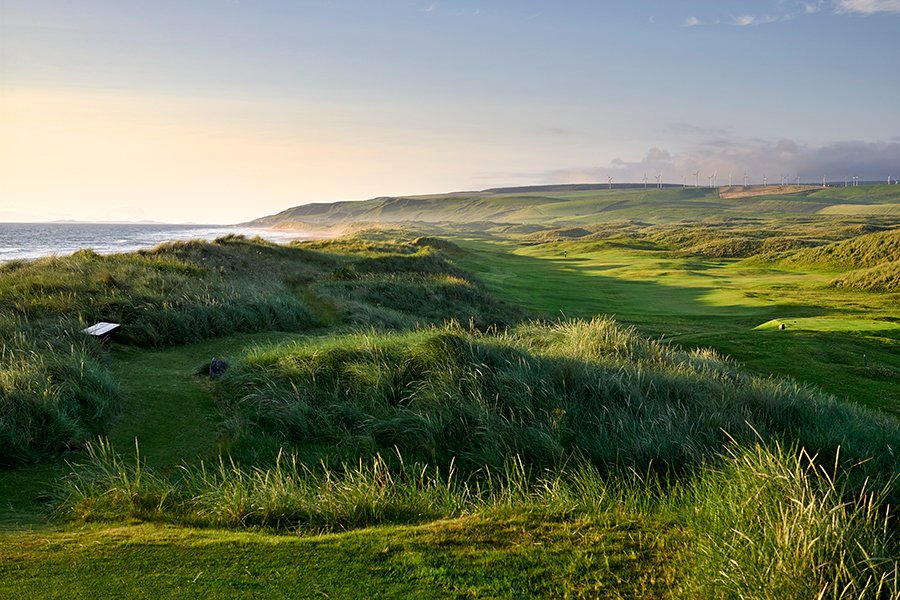Playing Machrihanish Dunes
The journey to the Mull of Kintyre by road is one of the great scenic drives that Scotland quietly offers the adventuring golfer: from Loch Lomond, through the Arrochar Alps, and then a loch-hugging drive that passes Inverary, Lochgilphead and Tarbert before the rugged Atlantic shore road leads you down to Machrihanish Dunes. Pick a time somewhere between June and July and the seaward sandbanks are a vibrant blue, covered deeply with native Scottish bluebells ringing silently in the ever-present zephyrs. Travel in March-April and they’re yellow with daffodils. The white-topped rollers lap the beaches yards from your bumper. Islands lie temptingly on the horizon, begging you to come and visit. It’s a pretty special experience.
Approaching the Club, the road becomes single-track until reaching an understated entrance to the course. The sea spreads out ahead of you, a full vista with the Isles of Jura and Gigha picked out darkly in the distance. There’s a slate roof which looks rather small for the size of the course: the owners, Southworth, who also run the nearby Royal and Ugadale Hotels, place the focus on returning to your accommodation for “post-round analysis” in the Black Sheep Pub, but they do a brilliant bacon roll at the Clubhouse. The Club’s black sheep logo adorns the gate’s stone wall, and whilst there’s lots of gentle dunes around, there’s not much in the way of fairways yet. It all becomes much clearer beyond the pretty, dark stone-walled Clubhouse.
Before scampering up to the first tee, it’s highly recommended to take some time to practice on their two large greens. They have a driving range too, but it’s the short game that will help you here… stories are frequently heard about the swales on the greens and getting the pace right will help. The lower green, with all its slopes, and the higher one perfectly replicate the feel of the course. All around the practice area high banks of marram are dissected by neatly mown paths offering anticipation in multiple directions.
There’s a choice of four tees to play, each a small oasis of tight turf surrounded by billowing high grasses. Off the tips it’s approaching 7100 yards on a par 72 card, and you start with the prevailing wind in your face. Ahead lies the 1st green… it’s tucked around a gently descending dogleg to the left, 294 yards away off the whites, somewhere in the rolling dunescape. The question of “Where?” is not uncommon during the round, but it’s not displeasing. Your introduction to the fairways and greens of The Dunes is soon revealed with your approach: a rolling, rippling fairway which carries through the green to its back. There are only a few places to land the ball on each green that won’t have you calculating both pace and angle to get near the pin. Suffice to say, take time to practice at the Clubhouse.
The walk-offs from all the greens take the player up welcoming paths sliced neatly through thick mounds of marram. Rising and rolling, hidden valleys in the fairways gather your ball to deny you a clear view, or a full shot, to make the green. The course skirts the nearby airfield and its old ammunition bunkers behind the razor-tipped fence, then brings you down to the shoreline; there is nothing quite like standing high above the marram, the dune cliff dropping behind you to a wide expanse of empty beach and miles of breaking surf. A windfarm to the north in the distance confirms a gathering breeze. The course plays as two 9-hole loops, with five tough, sometimes tight, doglegs. It’s worth remembering too that The Dunes’ design featured a return to creating “natural” non-revetted bunkers, which many courses around Scotland have now embraced. Marram eyelashes, crumbling edges… pray that you don’t end up in the face.
There are always a few holes that stick in your mind when playing a new course and the run of 4-5-6 doesn’t disappoint, summing up the nature of the course perfectly. The 4th, a 247-yard par-4 (whites), sounds tame. Ahead, a marker post floats above the wispy fescues… X marks the spot. What you can’t see is that the narrow, long green lies pretty much left to right across you, tucked into a valley and with steep banking encroaching the putting surface at alternate points, like cogs emanating from the framing dunes. The perfect shot would actually be a fade into its neck, but a left side approach is safer than right, and allows a view into the green. It’s common to have to make putts which take a roller-coaster ride up and down each side before gravity settles the ball near the centre.
The 5th is the signature hole of The Dunes, a beautiful par-3 facing the owner’s distant Ugadale Hotel and the dark hills behind Machrihanish. Very little ground was moved by David McLay Kidd and his team to create the course, and the SSSI areas throughout the plot partially required this strategy: but one of the key moves by a digger was a large dune behind the 5th green which enabled this view of their hotel. Good marketing strategy. A solitary pot bunker protects the near left, set into the green’s face, but can welcome a fast runner from the duned, higher right side where a drop to the beach sits only yards away. All tees, bar the reds, play from the same spot at 134 yards, and accuracy is essential. Even then, being on the sloping green is no guarantee of a par.
The 6th unusually brings another par-3, but this one flips the wind direction 180-degrees and presents a green that slopes away from the tee. A single pot bunker awaits at the back, and probably gets deeper every year thanks to its regular visitors. Any chip back into the breeze is better kept travelling low, in the way that links golf tirelessly demands, for the undulations are easier to cope with at that level – no awkward bounces off the generous swales that shape these putting surfaces.
Finally of note is the 17th hole, a blind drive over a near marker post that hopefully lands you safely between the undulations on a fairway framed by banks of marram that shift it first right, then left. From a decent lie, it’s nowhere near an easy approach. The dogleg-left fairway drops steeply ahead to a valley, often soft and certainly protected, to be crossed by a long wooden path. Climbing up, the green falls steeply left to the valley, is flanked right by a dune and falls away on all other sides. A bunker menacingly guards the approach face, mentally stretching the carry across the valley and demanding a perfectly placed cross-wind shot to the green. Now is not the time to doubt your swing.
The wildlife, the endless views and the re-assuring sounds of the Mull will embrace you as you effortlessly make your way through 18 amazing experiences. Machrihanish Dunes’ natural flow is something you’ll find difficult to match anywhere, as well as those constant memories of care-free, childhood days laughing your socks off with your friends on fiendishly difficult seaside putting greens.
As an experience, it’s hard to beat and worth the drive.




